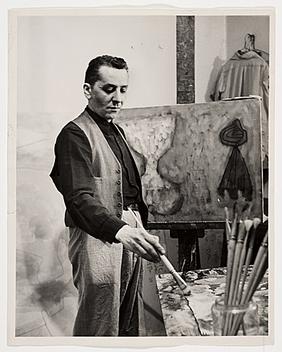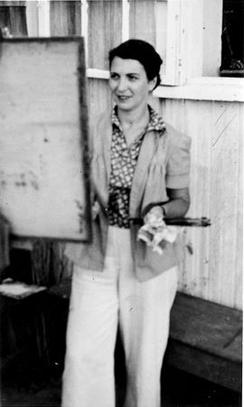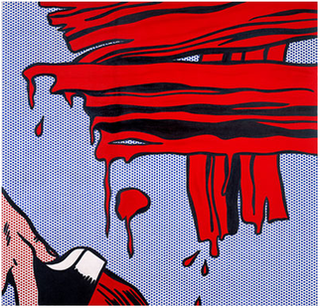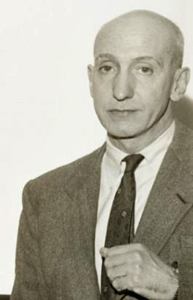Related Research Articles
Abstract expressionism in the United States emerged as a distinct art movement in the immediate aftermath of World War II and gained mainstream acceptance in the 1950s, a shift from the American social realism of the 1930s influenced by the Great Depression and Mexican muralists. The term was first applied to American art in 1946 by the art critic Robert Coates. Key figures in the New York School, which was the center of this movement, included such artists as Arshile Gorky, Jackson Pollock, Franz Kline, Mark Rothko, Norman Lewis, Willem de Kooning, Adolph Gottlieb, Clyfford Still, Robert Motherwell and Theodoros Stamos among others.

Clyfford Still was an American painter, and one of the leading figures in the first generation of Abstract Expressionists, who developed a new, powerful approach to painting in the years immediately following World War II. Still has been credited with laying the groundwork for the movement, as his shift from representational to abstract painting occurred between 1938 and 1942, earlier than his colleagues like Jackson Pollock and Mark Rothko, who continued to paint in figurative-surrealist styles well into the 1940s.

Malcolm A. Morley was a British-American visual artist and painter. He was known as an artist who pioneered in various styles, working as a photorealist and an expressionist, among many other genres. In 1984, he won the inaugural Turner Prize.

Barnett Newman was an American artist. He has been critically regarded as one of the major figures of abstract expressionism, and one of the foremost color field painters. His paintings explore the sense of place that viewers experience with art and incorporate simplistic forms to emphasize this feeling.

Richard Diebenkorn was an American painter and printmaker. His early work is associated with abstract expressionism and the Bay Area Figurative Movement of the 1950s and 1960s. In the late 1960s he began his extensive series of geometric, lyrical abstract paintings. Known as the Ocean Park paintings, these paintings were instrumental to his achievement of worldwide acclaim.
Robert Motherwell was an American abstract expressionist painter, printmaker, and editor of The Dada Painters and Poets: an Anthology. He was one of the youngest of the New York School, which also included Willem de Kooning, Jackson Pollock, and Mark Rothko.

Adolph Gottlieb was an American abstract expressionist painter who also made sculpture and became a print maker.

Gabriele Münter was a German expressionist painter who was at the forefront of the Munich avant-garde in the early 20th century. She studied and lived with the painter Wassily Kandinsky and was a founding member of the expressionist group Der Blaue Reiter.
Gabriel Laderman was a New York painter and an early and important exponent of the Figurative revival of the 1950s and 1960s.

Clementine Hunter was a self-taught Black folk artist from the Cane River region of Louisiana, who lived and worked on Melrose Plantation.

William Baziotes was an American painter influenced by Surrealism and was a contributor to Abstract Expressionism.

The New Orleans Museum of Art is the oldest fine arts museum in the city of New Orleans. It is situated within City Park, a short distance from the intersection of Carrollton Avenue and Esplanade Avenue, and near the terminus of the "Canal Street - City Park" streetcar line. It was established in 1911 as the Delgado Museum of Art.

Perle Fine (1905–1988) was an American Abstract expressionist painter. Fine's work was most known by its combination of fluid and brushy rendering of the materials and the use of biomorphic forms encased and intertwined with irregular geometric shapes.
Edward "Ed" Clark was an abstract expressionist painter known for his broad, powerful brushstrokes, radiant colors and large-scale canvases. An African-American, his major contributions to modernist painting remained unrecognized until relatively late in his seven-decade career, during which he pioneered the use of shaped canvases and a commercially available push broom to create striking works of art.
Caroline Wogan Durieux was an American printmaker, painter, and educator. She was a Professor Emeritus at both Louisiana State University, where she worked from 1943 to 1964 and at Newcomb College of Tulane University (1937–1942). Carl Zigrosser, Keeper of Prints at the Philadelphia Museum of Art, wrote:
"Durieux is master of her instrument. It is like an epigram delivered in a deadpan manner:the meaning sinks in casually; when all of a sudden the full impact dawns on one, it haunts one for days. Her work has that haunting quality because its roots are deep, its vision profound".

Stephen Greene was an American artist known for his abstract paintings and in the 1940s his social realist figure paintings.

Brushstrokes series is the name for a series of paintings produced in 1965-1966 by Roy Lichtenstein. It also refers to derivative sculptural representations of these paintings that were first made in the 1980s. In the series, the theme is art as a subject, but rather than reproduce masterpieces as he had starting in 1962, Lichtenstein depicted the gestural expressions of the painting brushstroke itself. The works in this series are linked to those produced by artists who use the gestural painting style of abstract expressionism made famous by Jackson Pollock, but differ from them due to their mechanically produced appearance. The series is considered a satire or parody of gestural painting by both Lichtenstein and his critics. After 1966, Lichtenstein incorporated this series into later motifs and themes of his work.

George McNeil was an American abstract expressionist painter.
Joe Wesley Overstreet was an African-American painter from Mississippi who lived and worked in New York City for most of his career. In the 1950s and early 1960s he was associated with the Abstract Expressionist movement.
Robert Rector is an American Postwar and contemporary painter.
References
- 1 2 3 "Edward Pramuk Bio" . Retrieved 19 April 2013.
- 1 2 3 "Ann Connelly". Ed Pramuk Biography. Archived from the original on 28 June 2013. Retrieved 19 April 2013.